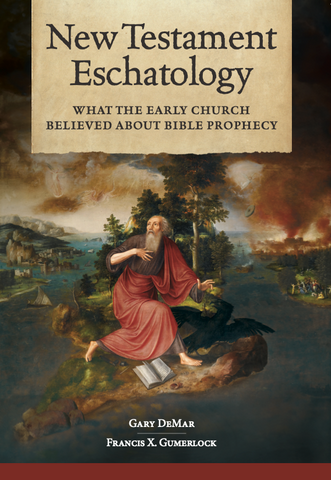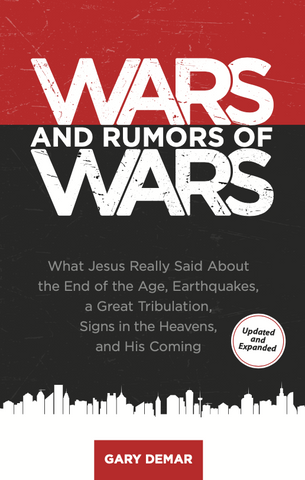Sam Frost used to be a full preterist. He published articles and books defending the full preterist worldview while he was at Whitefield Theological Seminary under the tutelage of Ken Talbot. In his book Misplaced Hope, Frost wrote that he owed Ken “large thanks. Although he may not be in agreement with my conclusions [about Sam’s views about preterism], he nonetheless has inspired my undertaking to justify what I do under the rubric of the Protestant and Reformed tradition.” But if anyone attempts to do something similar today, they must be denounced and damned! I can’t recall Sam being denounced and called a heretic by those who got degrees from WTS and signed the Three Questions Letter. How times have changed!
The latest attacks from Frost, Jason Bradfield, and Andrew Sandlin are related to the two-volume work The Hope of Israel and the Nations by Kim Burgess (mostly) and me. The publication of this work, based on 24 podcasts, was a massive undertaking. A lot of thought and 40 years of study by Kim went into its production. A few sloppily underlined sentences here and there with an * for emphasis seemingly pass for scholarship, as a critique has found its way on Facebook. It’s embarrassing.

The Hope of Israel and the Nations
Christians tend to learn the Bible in bits and pieces. As a result, they often miss the larger context because they have not been taught how the bits and pieces fit with the whole. It’s important to remember that the 66 biblical books make up one complete work—The Bible—The Book. With help from co-author Gary DeMar, Kim Burgess connects all the parts of the NT and fashions them into a whole. Kim emphasizes the one-and-many approach to interpretation. The parts and the whole must be studied together. They make up the warp and woof of proper biblical interpretation. The process takes time and study, but it brings the full story of the Bible into clear focus.
Buy NowFrost wrote a chapter for the book House Divided: Bridging the Gap in Reformed Eschatology—A Preterist Response to When Shall These Things Be? It was titled “Inconsistent Orthodoxy.” You should read Frost’s 2002 book, Misplaced Hope: The Origins of First and Second Century Eschatology and the Introduction of his “2nd Revised Edition” of Exegetical Essays on the Resurrection, and wonder at the certainty. After reading what Frost used to believe and dogmatized about, you might think he has an evil twin. I’ve never seen anyone make such a dramatic change from one form of unbridled dogmatism to another in such a short period of time using the same operating principle that, using Frost’s own words, “Scripture will suffice.” Scripture was also sufficient for Frost when he wrote as a full preterist.
All of us tinker with our views as we mature, grow in wisdom, ask questions, research, and bounce ideas off fellow Christians. That’s what I have done and will continue to do despite attempts by Frost to attribute beliefs to me that I do not hold. My goal has always been to get the topics on the table and deal honestly with them as Frost once attempted to do. Sam might want to contact Gentry about how falsehoods can irreparably damage someone’s reputation based on, as Ken once put it regarding something that happened to him, “some comments on a few errors that exaggerate reality.”
On page 9 of Frost’s Introduction to his 2010 book Exegetical Essays on the Resurrection he stated, “there is almost blind allegiance to the creeds…. On the one hand, Evangelicals will say with the Westminster Confession of Faith that the creeds ‘may err,’ but when asked which line of the Nicene Creed ‘may possibly err’ the answer is ‘none of them, so don’t ask again.’” The eschatological questioning regarding preterism, Frost wrote, “is being felt around the globe…. Many have not even seen their inconsistency. Non-Preterists become Preterists every day as some of the more recent attacks on Preterism are showing. The movement is growing. This is not itself validation of a movement, but it is proof that there is something there that needs to be looked at by Evangelicalism.” That was then; this is now.
After reviewing much of Frost’s recent work, some of it confusing and indiscernible, I will say what he and his followers will not like. Sam Frost cannot be trusted. We don’t know what Sam will believe tomorrow. Is he finished retooling his belief system, or is there more to come? You might not want to hitch your wagon to someone who changes horses so quickly in midstream.
Frost was afforded some grace during his vociferous promotion of full preterism. Don’t expect the same from him now when some (many?) Christians agree “that there is something there that needs to be looked at by Evangelicalism.” For Sam and his followers, there’s nothing to see. It’s all been settled, but for many “around the globe” that’s not the case.
Sam Frost and his anti-preterist compatriot Jason Bradfield have taken on the task to discredit me for my comments and questions regarding Bible prophecy. My questions are real and speak for many people, a point made by Frost’s earlier “evil twin.” While anti-full preterists claim the questioning is new, history states that it isn’t. Frost even mentions some works from the 1800s and 1917. There are many more.
Now to the latest frosting that was published on April 5, 2025. What a thing to wake up to on my birthday. Bradfield also responded to my article “Is Lip Service being Paid to Sola Scriptura?” with “Coming to Judge Gary DeMar: A Confessional Response to a Heretical Eschatology.” I have not read it. Who is Bradfield to judge anyone? I don’t want to disparage Frost and Bradfield, but they are minor players in theological circles as I am. I write for my benefit. Writing affords me the opportunity to think through questions that arise in my study of the Bible and the works of other writers. Here’s something Bradfield said about Sam some years ago:
I wish Sam would humble himself. I wish he would get off this kick of being a scholar —“I’m doing the real work here…”—and learn some humility…. You think he would have learned that lesson coming out of hyper-preterism.
People can agree or disagree, but it must be done in terms of Scripture. A little grace sprinkled in would go a long way. Neither I nor people who write to me asking questions are interested in “A Confessional Response … to Eschatology,” especially since most Christians are unaware of a document like the Westminster Confession of Faith. I am a member of good standing in my church. My membership does not require adherence to the WCF. I recite and believe the Nicene Creed. I have written on how I understand the history of the Nicene Creed in chapter 11 of my book with Francis X. Gumerlock New Testament Eschatology. It’s there for anyone to read. Few have done so.

New Testament Eschatology
It has been maintained by some modern writers that the early church was predominately premillennial and exclusively futuristic on Bible prophecy. According to this popular view, the early Christian writers who commented on prophetic passages like the Olivet Discourse (Matthew 24, Mark 13, Luke 21) believed and wrote that the biblical authors were always referring to events in the distant future just before something called the “rapture” or the return of Christ. While these claims have been made with certainty, there has always been a lack of clear historical documentation to support them. New Testament Eschatology challenges this prevailing futurist view with a careful study of the historical record. The evidence shows that many early church writers understood the destruction of Jerusalem in AD 70 to be the end of the Old Covenant world.
Buy NowNow to Frost’s short diatribe that caught my attention because of its absurdity and dangerous conclusions. Frost’s a smart guy, but he has missed the boat on this one. He’s so desperate to disparage me that he undermines the integrity of the Bible. Here’s some of what he wrote:
“I guess DeMar is convinced that Jesus descended from the heavens and raised the dead, changing the living all over the ‘Roman world’ at 5:00 PM, Month of Ab, day 9 [I think it was day 10]. Gary, of course, is under the heavy weight of explaining what that ‘looked like’ for Joe Corinth, living 2000 miles away when Titus saw the Temple burning. We need some explanation here ‘from the Scriptures’ that Gary is so adamant about. What ‘change’ in a ‘flash’ … did Betty Thessalonian ‘experience’ when Jesus ‘came again’ and destroyed Jerusalem? Did she ‘feel it’ at ‘the moment’? Was she ‘changed’ at that point?”
When someone begins with, “I guess,” you know what’s coming … a guess. I’ve written a lot of material over the years, more than Frost and Bradfield combined. It’s not hard to determine if I’ve ever said, “Jesus descended from the heavens and raised the dead, changing the living all over the ‘Roman world.’” I never said any such thing. Go to AmericanVision.ai and ask if Gary DeMar believes Jesus physically returned in AD 70 to raise dead bodies from their graves. Frost is “bearing false witness.” I’ve made my views on Matthew 24-25 and other prophetic passages very clear. I’m waiting to read Gentry’s commentary on Matthew 24:35-25:46.
It’s not surprising that Frost and Gentry use sarcastic diatribes in their critiques rather than deal with the questions being raised about specific passages and the lack of unity among those who signed the Three Questions Letter since Frost claims that “Scripture will suffice.” If it’s as sufficient as they claim, then why can’t they agree on what passages refer to a future physical coming of Jesus?
If you’ve ever watched a theatrical pickpocket, you know what I mean. These stage pickpockets use sleight of hand and misdirection to “steal” items from audience members without their knowledge right before your eyes. Frost does this with his sarcastic story of what people far from Jerusalem felt about events that took place in Jerusalem. How could what happened in Jerusalem have any impact on them? I wonder what those who heard the gospel preached far from Jerusalem “felt” and “experienced” when some tentmaker named Paul described how someone named Jesus died on the cross for their sins, and by believing in Him, they would be “new creations”? Someone might say, “I have a friend who believes in this Jesus, but nothing I see has changed. There’s nothing “new creation” about him. But you say I’ll be a ‘new creation’ if I believe in Jesus who I have never seen. How does that work?” The Hope of Israel lays it all out.
And when the story of Jesus is told today around the world, many might ask, “How does what some Jewish man who died 2000 years ago have any relevance for me today? “I’ll be ‘born again’? How does that work? Is it like reincarnation?” What did the gospel message look like “for Joe Corinth, living 800 miles away” when Jesus died on the cross and rose from the dead decades before?
I’m shocked that Frost would use such an obviously flawed argument. What did those who were told Jesus would return before their generation pass away see as described by Him in Matthew 24:30? Preterists like Ken Gentry believe this happened just like Jesus said it would.

Wars and Rumors of Wars
A first-century interpretation of the Olivet Discourse was once common in commentaries and narrative-style books that describe the fall of Jerusalem in AD 70. There is also a history of skeptics who turn to Bible prophecy and claim Jesus was wrong about the timing of His coming at “the end of the age” and the signs associated with it. A mountain of scholarship shows that the prophecy given by Jesus was fulfilled in exacting detail when He said it would: before the generation of those to whom He was speaking passed away.
Buy NowThey saw the destruction Jesus said would happen before their generation passed away (24:34), but they did not physically see Jesus. What relevance was this event for them and the rest of the Roman world at that time? “Did they ‘feel it’ at ‘the moment’? Were they ‘changed’ at that point?” “What ‘change’ in a ‘flash’ … did Betty Thessalonian ‘experience’ when” she was told that Jesus died on the cross for her sins and rose from the dead? She didn’t see or experience it. But those events and those that preceded them in the ministry of Jesus had profound relevance to those far away in time and distance just like they do today. If not, then there is no gospel, and all we are doing is “striving after wind.” (Eccles. 1:14)
If God does something outside the bounds of our experience, it means something whether Sam Frost believes it or not. What did Joan Ephesian see and experience when she was “raised up with [Jesus] and was seated with Him in the heavenly places”? (Eph. 2:6) What did it mean for Mr. Colossian to be “buried with Him in baptism … and raised up with Him”? (Col. 2:12) No one was physically raised up. Most likely it wasn’t only the Ephesians and Colossians who were raised up. No one saw anyone rise, but it happened and meant something!
Did Jesus physically come so “every eye” would see Him? (Rev. 1:7) Gentry says no. He spends more than 20 pages defending his “no” position in volume one of his Divorce of Israel commentary on Revelation. What would “the Lord riding on a swift cloud” look like to those who first read Isaiah 19:1 so that the idols of Egypt would “tremble at His presence”? “At His presence”?
What about the resurrection in Daniel 12? Here’s what Gentry wrote about it, but Sandlin disagrees.
In Daniel 12:1-2 we find a passage that clearly speaks of the great tribulation in AD 70: “Now at that time Michael, the great prince who stands guard over the sons of your people, will arise. And there will be a time of distress such as never occurred since there was a nation until that time; and at that time your people, everyone who is found written in the book, will be rescued” (12:1). But it also seems to speak of the resurrection occurring at that time: “And many of those who sleep in the dust of the ground will awake, these to everlasting life, but the others to disgrace and everlasting contempt” (12:2).
How are we to understand this passage? Does Daniel teach that the eschatological, consummate resurrection occurs during the great tribulation in AD 70? No, he does not. Let me explain.
Daniel appears to be presenting Israel as a grave site under God’s curse: Israel as a corporate body is in the “dust” (Da 12:2; cp. Ge 3:14, 19). In this he follows Ezekiel’s pattern in his vision of the dry bones, which represent Israel’s “death” in the Babylonian dispersion (Eze 37).[1] In Daniel’s prophecy many will awaken, as it were, during the great tribulation to suffer the full fury of the divine wrath, while others will enjoy God’s grace in receiving everlasting life. Luke presents similar imagery in Luke 2:34 in a prophecy about the results of Jesus’s birth for Israel: “And Simeon blessed them, and said to Mary His mother, ‘Behold, this Child is appointed for the fall and rise of many in Israel, and for a sign to be opposed.’”
*****
So the resurrection in Daniel 12 does not associate the consummate resurrection with the AD 70 tribulation. Daniel only picks up on resurrection imagery and, like Ezekiel, applies that to corporate Israel. He is teaching that in the events of AD 70, the true Israel will arise from old Israel’s carcass, as in a resurrection.[2]
Consider the language of Ezekiel 37: “I will open your graves and cause you to come up out of your graves.” (vv. 12-13) Is or was this a physical resurrection? Most commentators say no. Paul was on trial for “the resurrection of the dead.” (Acts 23:6; 1 Cor. 15:13). Is this the resurrection Paul was describing and assuring the Thessalonians that those Old Covenant saints would be raised (1 Thess. 4:13-18), and those who died under the auspices of the New Covenant would go directly to heaven, thus, bypassing sheol/hades? Christians often ask, What happened to the Old Covenant saints at death? Some Christians believe they get a new body at death. They believe the traditional view leaves those who have died unclothed in gnostic fashion. It’s unnatural for humans to be separated from their physical nature.
The questions surrounding eschatology are not going away. Calling me a heretic for asking questions and poking those who have everything figured out (they don’t and neither do I) is not making their arguments and criticism ipso facto valid. Eschatology has been jerry-rigged for centuries. It wouldn’t hurt to reinvestigate the topic without throwing stones.
[1] “See: Dictionary of Biblical Prophecy and End Times, 148. Thus, Da 12 does not directly teach individual, bodily resurrection. Nevertheless, the fact that it uses such language shows that a literal bodily resurrection lies behind the image, and so it indirectly affirms the future bodily resurrection.”
[2] Kenneth L. Gentry, “Resurrection in Daniel 12:2” (Nov. 21, 2014): Link here.

